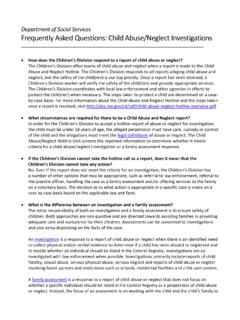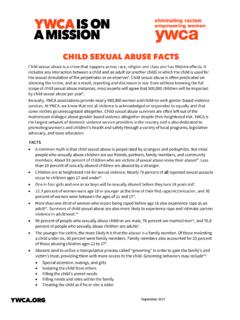Transcription of Recognizing Child Abuse and Neglect: Signs and Symptoms
1 Department of Health and Human Services Administration for Children and Families Administration on Children, Youth and Families Children s BureauChild Welfare Information GatewayChildren s Bureau/ACYF1250 Maryland Avenue, SWEighth FloorWashington, DC or : 2007 The first step in helping abused or neglected children is learning to recognize the Signs of Child Abuse and neglect. The presence of a single sign does not prove Child Abuse is occurring in a family, but a closer look at the situation may be warranted when these Signs appear repeatedly or in you do suspect a Child is being harmed, reporting your suspicions may protect the Child and get What s Inside: Recognizing Child abuseTypes of abuseSigns of physical abuseSigns of neglectSigns of sexual abuseSigns of emotional maltreatment Recognizing Child Abuse and Neglect: Signs and SymptomsDisponible en espa Child Abuse and Neglect: Signs and This material may be freely reproduced and distributed. However, when doing so, please credit Child Welfare Information Gateway.
2 Available online at for the family. Any concerned person can report suspicions of Child Abuse and neglect. Some people (typically certain types of professionals) are required by law to make a report of Child maltreatment under specific circumstances these are called mandatory reporters. For more information, see the Child Welfare Information Gateway publication, Mandatory Reporters of Child Abuse and Neglect: more information about where and how to file a report, contact your local Child protective services agency or police department. An additional resource for information and referral is the Childhelp National Child Abuse Hotline ( ). Recognizing Child abuseThe following Signs may signal the presence of Child Abuse or Child :Shows sudden changes in behavior or school performanceHas not received help for physical or medical problems brought to the parents attentionHas learning problems (or difficulty concentrating) that cannot be attributed to specific physical or psychological causesIs always watchful, as though preparing for something bad to happen Lacks adult supervisionIs overly compliant, passive, or withdrawnComes to school or other activities early, stays late, and does not want to go homeThe Parent.
3 Shows little concern for the childDenies the existence of or blames the Child for the Child s problems in school or at homeAsks teachers or other caregivers to use harsh physical discipline if the Child misbehavesSees the Child as entirely bad, worthless, or burdensomeDemands a level of physical or academic performance the Child cannot achieveLooks primarily to the Child for care, attention, and satisfaction of emotional needsThe Parent and Child :Rarely touch or look at each otherConsider their relationship entirely negativeState that they do not like each othertypes of Abuse The following are some Signs often associated with particular types of Child Abuse and neglect: physical Abuse , neglect, sexual Abuse , and emotional Abuse . It is important to note, however, that these Recognizing Child Abuse and Neglect: Signs and Symptoms This material may be freely reproduced and distributed. However, when doing so, please credit Child Welfare Information Gateway. Available online at of Abuse are more typically found in combination than alone.
4 A physically abused Child , for example, is often emotionally abused as well, and a sexually abused Child also may be neglected. Signs of Physical abuseConsider the possibility of physical Abuse when the Child :Has unexplained burns, bites, bruises, broken bones, or black eyesHas fading bruises or other marks noticeable after an absence from schoolSeems frightened of the parents and protests or cries when it is time to go homeShrinks at the approach of adultsReports injury by a parent or another adult caregiverConsider the possibility of physical Abuse when the parent or other adult caregiver:Offers conflicting, unconvincing, or no explanation for the Child s injuryDescribes the Child as evil, or in some other very negative wayUses harsh physical discipline with the childHas a history of Abuse as a Child Signs of NeglectConsider the possibility of neglect when the Child :Is frequently absent from schoolBegs or steals food or moneyLacks needed medical or dental care, immunizations, or glassesIs consistently dirty and has severe body odorLacks sufficient clothing for the weatherAbuses alcohol or other drugsStates that there is no one at home to provide careConsider the possibility of neglect when the parent or other adult caregiver:Appears to be indifferent to the childSeems apathetic or depressedBehaves irrationally or in a bizarre mannerIs abusing alcohol or other drugsSigns of sexual abuseConsider the possibility of sexual Abuse when the Child :Has difficulty walking or sittingSuddenly refuses to change for gym or to participate in physical activitiesReports nightmares or bedwetting Recognizing Child Abuse and Neglect: Signs and material may be freely reproduced and distributed.
5 However, when doing so, please credit Child Welfare Information Gateway. Available online at a sudden change in appetiteDemonstrates bizarre, sophisticated, or unusual sexual knowledge or behaviorBecomes pregnant or contracts a venereal disease, particularly if under age 14 Runs awayReports sexual Abuse by a parent or another adult caregiverConsider the possibility of sexual Abuse when the parent or other adult caregiver:Is unduly protective of the Child or severely limits the Child s contact with other children, especially of the opposite sexIs secretive and isolatedIs jealous or controlling with family members Signs of emotional Maltreatment Consider the possibility of emotional maltreatment when the Child :Shows extremes in behavior, such as overly compliant or demanding behavior, extreme passivity, or aggressionIs either inappropriately adult (parenting other children, for example) or inappropriately infantile (frequently rocking or head-banging, for example)Is delayed in physical or emotional development Has attempted suicideReports a lack of attachment to the parentConsider the possibility of emotional maltreatment when the parent or other adult caregiver:Constantly blames, belittles, or berates the childIs unconcerned about the Child and refuses to consider offers of help for the Child s problemsOvertly rejects the childChild Abuse and Child Abuse and Child Abuse and Child Abuse and e s o uR Ce s o n t h e C hI l d W e l faR e I n f oR m atI o n G at eWay W e b sI t eThis factsheet was adapted, with permission, from Recognizing Child Abuse : What Parents Should Know.
6 Prevent Child Abuse America. 00.














